Interview: Cardboard Computer
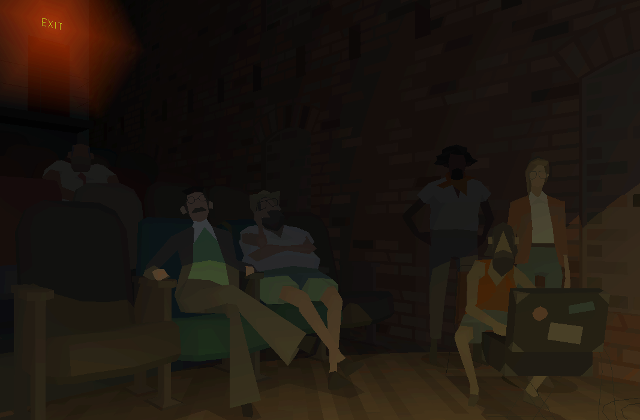
Kentucky Fried Zero: Inside the Actors Studio; Or is this Outside?
As with the previous pieces on Kentucky Route Zero we’ll delve deep into the backgrounds and inspirations of the game, so obviously: Spoilers.
One might come to the conclusion that Cardboard Computer are a lazy bunch. It has been over half a year since the last installment. But actually Jake Elliott, Tamas Kemenczy and Ben Babbitt have kept busy since the release of Act 2. Jake and Tamas produced a game each for the Experimental Game Pack 01, Babbitt released End-dance a new Pillars And Tongues record and just recently they got together again to publish the second free Intermission episode The Entertainment.
The Entertainment is a virtual theatre performance, optimized for Oculus Rift, the Kickstarter funded virtual reality goggles. The performance is staged by well known characters from the main game. The play itself is a one act bar room tragedy about the drinking life, debt and a looming rapture. The main inspiration for The Entertainment seems to be Eugene O’Neill’s The Iceman Cometh and the work it was inspired by, Maxim Gorky’s The Lower Depths. In both plays tragedy ensues when one person threatens the comforting illusions of a cast of downtrodden characters, arguing that one cannot face such bleak realities without losing one’ mind. Also featured are the infamous and absurd Raines Law Brick Sandwiches.
To find out more about these inspirations I decided to have a chat with Jake Elliott, Tamas Kemenczy and Ben Babbitt.
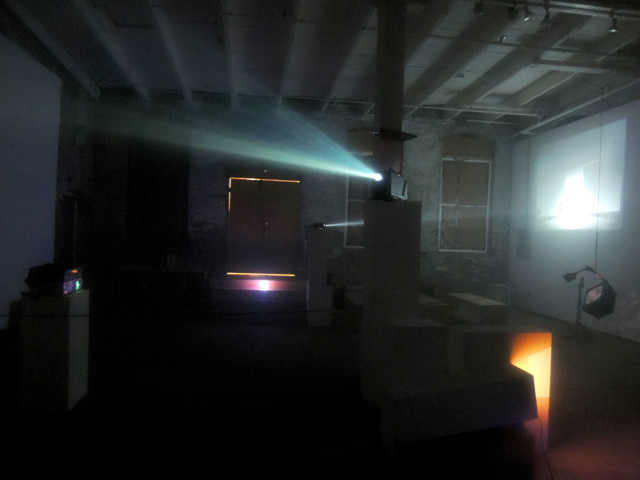
Before we come to The Entertainment, I’d like to ask you about the Lula Chamberlain retrospective exhibition you “curated” recently. Can you tell us about that?
Jake Elliott The Limits & Demonstrations exhibit was all organized and realized by Lee Tusman and a few of his collaborators. Lee is an artist in Philadelphia who’s done some really cool curatorial work regarding games, like the “Punk Arcade” project he’s done with Sarah Brin.
He got in touch with us in August, with the idea of staging a real-world simulation of the Lula Chamberlain exhibition presented in Limits & Demonstrations. So he and his team re-created the pieces from the game at a Philadelphia gallery called Little Berlin. During the exhibition run, they also did live play-throughs of Limits & Demonstrations, with guest artist appearing to read the three characters’ (Ben, Emily & Bob) dialog aloud. All very surreal and amazing, from our perspective!
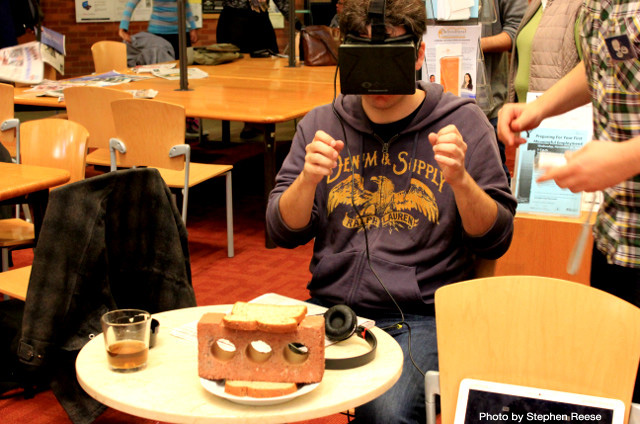
You premiered The Entertainment at the WordPlay festival for writing in contemporary games. What’s your take on the current state of writing in video games?
Jake Elliott The recent popularity of Twine is huge for writing in games. There’s been a lot of great game writing in the interactive fiction community for many years, but the approachability of Twine has brought in a lot of new voices lately. Not just approachability for designers, but also for players! Since the output of Twine is effectively small websites, it happens to be playing to a very basic literacy right now. It’s very exciting that “writing” as a skill is becoming a popular point of entry for game development, thanks to Twine.
With all the theatre inspirations in Kentucky Route Zero, has one of you got past practical experience in theatre? Are there theories of drama or practices that inform development?
Jake We’re very much amateurs in that area; we’ve learned more about theater from working on this game than we ever knew before. We’re still not very familiar with the theoretical side of drama, but practically we’ve been most inspired by set designers. The designers that we like the most play with making their sets more emotional than rational, and blending interior/exterior environments. A favorite example of this is Beowulf Boritt’s set for “The Glass Menagerie”, where the view through the apartment’s window fills the whole rear of the stage. Another is Jo Mielziner’s original set for “Death of a Salesman”, designed according to Arthur Miller’s instruction that the walls between rooms become permeable in certain scenes.
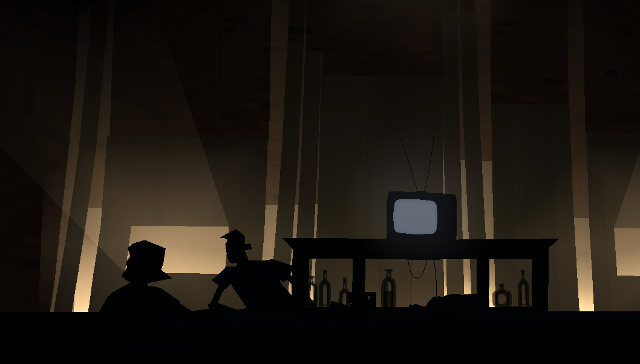
You make extensive use of lighting in The Entertainment. Have you looked at the works and writings of Robert Edmond Jones?
Tamas Kemenczy We actually haven’t! But I can see the correlation. Lighting in the game was particularly tuned for conveying the passage of time, and how a bar’s atmosphere can weigh on you throughout the day simply by the inversion of natural and artificial light. It’s evocative of being a regular at a bar, lingering around from morning to evening. Likewise, the slow spotlights are there to illustrate an inebriated or distracted mind, as if getting lost on some peculiar moment or train of thought as your surroundings fade away.
Kentucky Route Zero has a very specific look, was it difficult to adapt the style to the requirements of Oculus Rift?
Tamas There are some things that didn’t fit with the Rift for technical reasons, like the Bressenham aliased edges, but for the most part the graphics were straightforward to transcribe. The foremost problem we had to solve was the text presentation and how to make it feel natural and comfortable to read.
The non-hd headset’s resolution is pretty low, making small print hard to read, but it ended up being an interesting constraint for Jake to write for. The dialog took on the quality of reading subtitles, including the pacing of spoken words.
And because of depth perception, we had to really consider where the text will exist in three-dimensional space. We tried simulating the familiar spatial dynamics of reading a book, by placing the text under your nose, and then again by fixing the text to the headset as if they were subtitles, but both those ended up being a strain on the eye. Managing focal depth turned out to be really important and we found that the best approach was to minimize focal changes along the line of sight by placing the text at the same distance as the action on the stage.
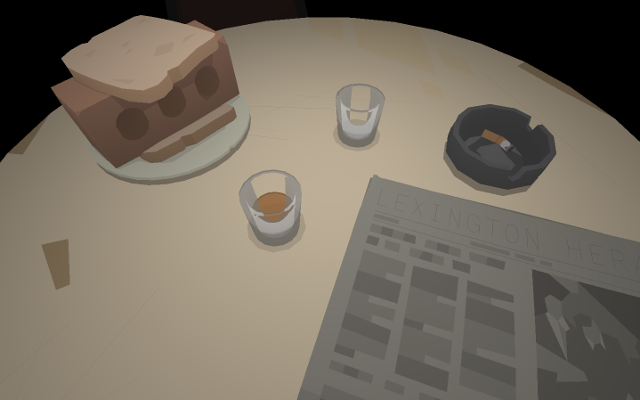
I was enthusiastic about earlier VR efforts like the CAVE system, and I’m enthusiastic about the VR trend now. It’s not the first time we’ve heard VR framed as the future of something, or as hegemonic outcome for computer graphics. I think an important aspect this time around is that the tech is not prohibitively expensive anymore, so I just see it as having a more active presence in the graphics ecosystem. I’m also looking forward to other projects gaining more traction, like castAR. The Rift is good at being a sort of sensory deprivation tank, simulating disembodiment and creating a new social context, while castAR instead integrates bodies and a familiar social context with a simulated setting. They play at very different states of mind I think, and both can exciting additions to games.
Let’s talk about music for a bit. Ben Babbitt’s song Letter Full of Promises, being based on Sun Ra’s Doo-wop recordings, seems a bit different from the Kentucky Route Zero’s usual quite bluegrass focused song selection. How come
Ben Babbitt The Sun Ra Doo-wop reference was somewhat arbitrary in that it wasn’t a deliberate move away from the bluegrass stuff, I was just really drawn to the clear and earnest quality of the voice. I had made that piece in a quick spurt apart from the game and it went unused for a little while before seeming to fit the strange, melancholic vibe one might sense in a place like the Lower Depths.
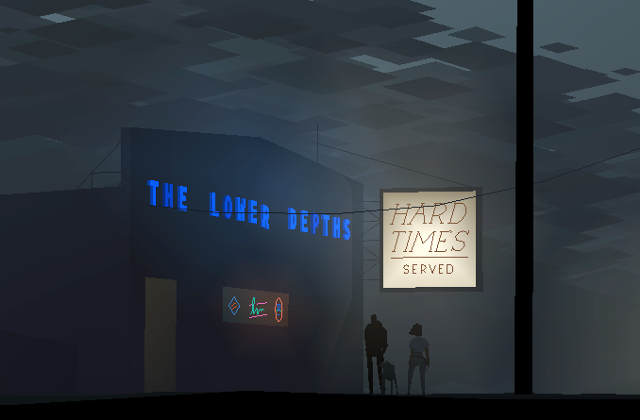
So, when not pushing yourself with finishing Act III for us, what games are you playing at the moment?
Jake Simogo’s “Device 6” is one we’ve been into recently. Excellent design from them as usual, especially with regard to the audio and typography in this one.
We’ll close this interview with a question from the Bernard Pivots questionnaire. What is your favorite curse word?
Jake I won’t speak for Tamas, but my favorite curse word is “shitty.”
Tamas That’s a tough one to settle on! I probably say ‘fuck’ the most absentmindedly, but I’ll pick ‘horseshit’ since I’d use it if something really got my goat…
Guest author Magnus has neither a Facebook nor a Twitter, but on Wednesday mornings you just might run into him at the Stadtbad Schöneberg in Berlin.